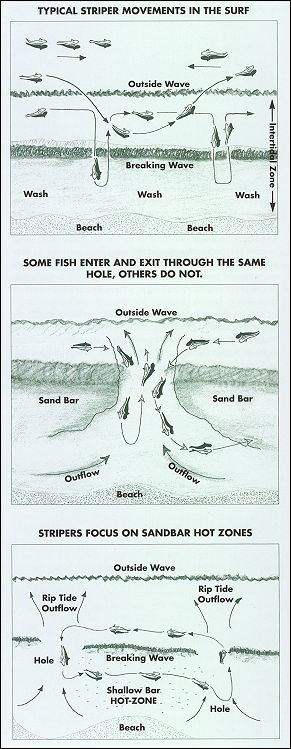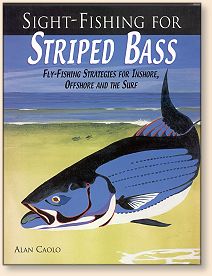Offshore Flats
On offshore flats, stripers are typically
found in schools, migrating northbound in
the spring and southbound in fall. Many
schools hold over prey-rich flats and feed
for several days before resuming their journey.
In midsummer the schools thin out and few fish
are found here in general. However, summertime
schools are still far more prevalent offshore
than on inshore flats or sight-fishing beaches,
where they are seldom encountered.

Offshore schools are spectacular sights where
impressive numbers of fish (routinely in the
hundreds) move across the open flat in waves.
Adjacent to islands, along grass shoals or
running parallel to other structure, schools
commonly stretch out lengthwise and parade
along the structure in a seemingly endless
progression of fish. School movements are
largely influenced by tides where the fish
prefer to migrate into the current.
Large numbers of fish do not necessarily mean that
the fishing will be fast and easy. Many of these
migrating fish are more interesting in crossing
the flat than chasing a tiny bit of food. Much
like tarpon transiting tropical flats in spring,
stripers (especially the large ones) migrating
over offshore flats can be difficult to entice
with a fly. Everything must be right to the big
fish - fly, presentation and your stealth. The
sheer number of fish in these schools make them
great targets for presentation. Early-season fish,
arriving in May and June, are often more aggressive
than the stripers encountered later in the season.
This is most likely the result of carryover migratory
feeding in waters that are still relatively cool.
Single fish and small groups, or pods, are also found
here. Again, fish moving quickly in one direction are
likely in transit and unlikely to feed. Small groups
of relocating fish often swim in strings (head-to-tail
in single file). Strings of bass may look like
tempting school configurations to cast to, but in
fact they are very difficult as they are not feeding
and are easily spooked. Slow-moving or meandering
fish are good target as they are most likely foraging
on the bottom.
Inshore Flats
Most of the striper's non-feeding movement occurs in
channels and in deep waters adjacent to inshore flats,
while every fish spotted on the flats is likely
feeding. They work the current-swept open flats both
with and against the tide. Generally, fish feed into
the tide quickly, staying on course in one direction.
When feeding with the current, they do it slowly,
and meander about in the process. They progress at
about the same speed as the tide, which they use to
push them along. Anglers should account for this
in their presentation and not lead these slow-moving
fish too far since the current naturally carried
the fly away from them.
Stripers love to work edges. During high tide
they take advantage of high water levels and
slowly prowl the shoreline for crabs and small
baitfish that use the banks for cover. They
often cruise well into shoreline coves and
tidal outflows as they feed. There may be a
bass wherever the water is deep enough along
the water's edge. At low tide, stripers cruise
the edges of drop-offs where the water is still
deep and schooling prey is often concentrated.
They meander on and off the flat as they travel
the edge. Strings of bass are commonly seen
moving quickly into the tide along these same
edges, but they are usually uninterested in
chasing flies and are not good targets.
Stripers use channels within inshore flats for
both traveling and feeding. When traveling they
swim along the bottom of deep channels where the
current is less and they usually remain unseen.
Shallow channels, however, make great feeding lanes
where shrimp and small baitfish are swept down tide
in the current. They typically run one to three
feet deeper than the surrounding waters and with
good light bass are easily spotted. Stripers
may swim into the current as they pursue baitfish,
or hold along the bottom and intercept fragile
prey, such as shrimp and juvenile flounder, that
drift with the tide.
The Surf
In the complex surf environment, with intricate hole
and sandbar formations, continuously changing currents
and waves, striper movements are also complex. Striped
bass work the surf both outside and waves, in parallel
tracks along the beach and inside the waves throughout
the intertidal zone.
Fish moving parallel to the shore are known as "cruisers."
They may be very close to the water's edge on a high tide
with low surf, or they may be well outside the wave-break
at low tide. When cruising the shoreline, either in
close or outside the waves, slow-movers are again
feeding while fast-moving fish are not likely to
break from their track to chase a fly.
Fish working the intertidal zone are known as
"surfers." These fish are always solitary and
they move in wave-like patterns as they feed.
Surfers work the intertidal zone by meandering
through it as they progress down the beach, or
they may follow a parallel track spiked with
sudden shoreward rushes behind rolling waves
into the zone. Stripers surfing the intertidal
zone are actively feeding and usually move fast
in this agitated water - they are very good
targets. Bass are commonly encountered gliding
through the wash as the foam dissipates in a foot
of water. These shallow-water surfers can appear
suddenly out of nowhere, surprising even veteran
sight-fishers, making this fishing extremely exciting.
Stripers probe every surf feature, investigating
every possible opportunity for food, and they
know them all. Sandbars, holes (rip tides) and
sand plumes (muds), are three favorites.

Sandbars form along shallow-profile beaches and
they often hold prey. They are frequently flanked
by holes, or rip tides that are cut in the bottom
by the surf. Stripers search these sandbars for
prey that is swept in the currents associated
with the adjacent rip tides. They enter those
holes from outside the surf, swim into shore
and then return outside through the same hole
and continue down the beach. Other times when
a sandbar is particularly fruitful, they comb
the whole bar by entering through one hole, swim
parallel to the sandbar and exit through a different
hole at the other end. Stripers often repeat this
pattern, thus circling the sandbar. Bars are on
the order of 100 feet or more in length and one
time around the entire formation can take 10 to
20 minutes.

When the surf in breaking on the beach, as opposed
to rolling in from further out, dense sand plumes
or muds are created very near shore with the
crashing waves. These muds contain all short
of unearthed surf-prey that gets pushed out in
the plume and becomes easy prey for bass that
dart in and out as they swim along the beach. ~ Alan Caolo
Credits: Excerpt and photo from Sight-Fishing
for Striped Bass Fly-Fishing Strategies for Inshore,
Offshore and the Surf, by Alan Caolo, Published by Frank
Amato Publications. We appreciate use premission. |



